| 1 | Dog-faced watersnake |
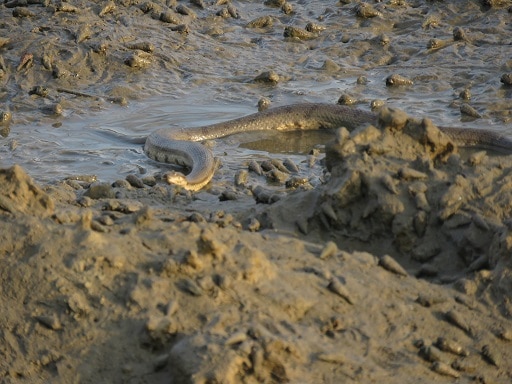
A semi-aquatic species of south-east Asia. Dog-faced watersnakes live in muddy estuaries and tidal flats, avoiding the sea itself. They hug the entire coastline of India, spreading to Phuket, Thailand. Dog-faced watersnakes eat 100% fish, but have particularly terrible eyesight. Scientists have placed a fish just feet from them in experiments, and triggered no reaction.
Instead, dog-faced watersnakes are ultra sensitive to water vibrations. By sensing a slight change in flow, they can tell if a fish is approaching, predict their line of travel, and grab them all within a few seconds. Sometimes they don’t need these methods, as dog-faced watersnakes can enter muddy tidal pools and slither directly through schools of fish with their jaws snapping. But it doesn’t hurt to have a backup, and the dog-faced watersnake is more than successful. They’re quietly one of Asia’s most common snakes, with millions and millions along its muddy coastlines.
Dog-faced watersnakes are so sensitive to water vibrations that they’ll swivel to attention if one drop lands on their pool. This is a mildly venomous species which sometimes chews fish for 15 minutes before swallowing. Dog-faced watersnakes have a particular taste for mollies and ricefish, making up 35.4% and 54.1% of their prey respectively.
| 2 | Central American bushmaster |
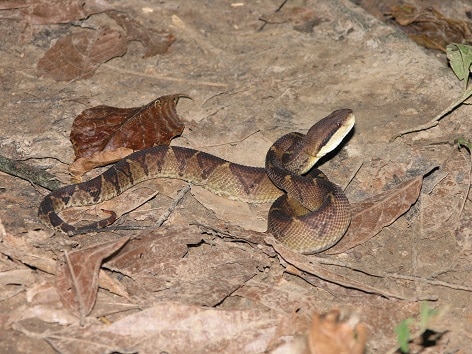
The Central American bushmaster is a thick-bodied species of Costa Rica and Panama, which lives in forests receiving 2000-4000mm of rainfall annually. It’s the 4th longest venomous snake in the world, at 3.6 metres against the king cobra’s 4 metres. Rather than charging around and terrorising forests, Central American bushmasters prefer to curl up in bushes and wait for prey to come to them. They can wait in undergrowth for several weeks, biding their time.
Nothing unusual for a snake then, but Central American bushmasters take it to the next level and preferentially choose welfia trees. These are especially attractive to rodents, with a plentiful supply of fruit dropping off their branches. Central American bushmasters coil up at the base of these thick rainforest trees and wait. They know that compared to a random no-name tree, their ambush schemes have a far higher chance of success. When the rodent arrives, they swallow them whole, unless its danger instincts activate in time.
The same thing has been observed in their close relative, the black-headed bushmaster of southern Costa Rica, despite the two diverging 4-11 million years ago. The welfia tree tactics must have evolved in the common ancestor of the two.
| 3 | Various: fluorescent tails |
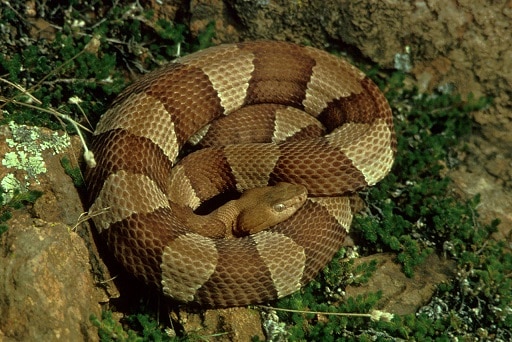
Around the world, there’s several dozen snakes which lure prey with their tails, AKA caudal luring. They have bright tail tips (pink, orange) and writhe them to mimic an earthworm or larvae. In 2021, a study detailed how some snakes take this to the next level by having fluorescent tails. They have tail tips which absorb photons and re-emit them in longer wavelengths, causing them to have a low, throbbing glow.
The study included numerous rattlesnakes and southeast Asian pitvipers. Some had the fluorescence just as youths, but many kept it into adulthood. One that kept it was Agkistrodon laticinctus, AKA the broad-banded copperhead. This is a relative of the traditional copperhead, inhabiting Kansas, Oklahoma and central Texas. It’s strongly venomous, yet is sluggish, making tail waggling a logical choice.
The scientists had many theories about the benefits of fluorescence. One was that it was mimicking specific fluorescent insects – larvae of the Hummingbird clearwing moth and honeysuckle bee hawkmoth, which are green and glowing before sprouting wings in adulthood. But mimicking grass was another theory. Some grass stalks have fluorescent tips which attract rodents searching for edible flowers. The rock rattlesnake had a tail tip particularly similar to these grasses.
| 4 | Tentacled snake |
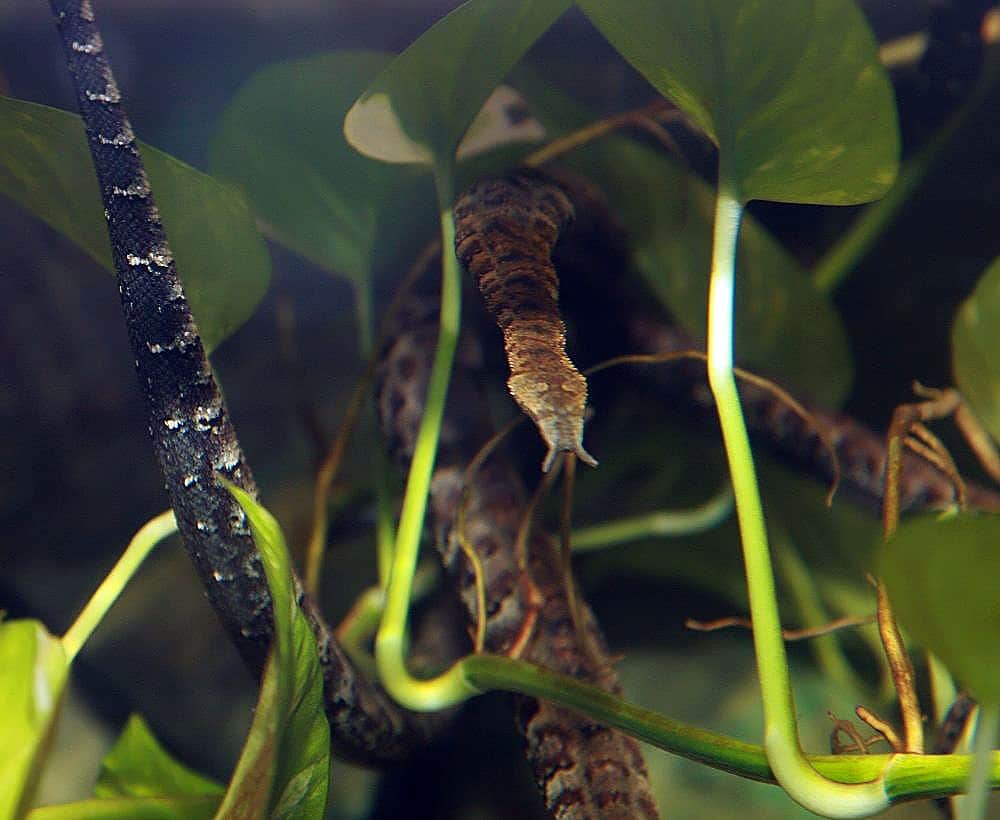
One of the more bizarre snakes on Planet Earth. Tentacled snakes (Erpeton tentaculatum) live in murky, silty swamps of southeast Asia, including Thailand, Vietnam and Cambodia. They’re no threat to humans, except maybe by inspiring nightmares. The namesake tentacles sprout from their face, and are fleshy rather than solid.
Tentacled snakes have the same water-sensing skills as a dog-faced watersnake. Through subtle current changes, they know exactly when a fish is approaching. Tentacled snakes assume a J-shape when preparing to strike, bent at the neck, and this is where they take underwater hunting to the next level. When startled, many fish have an instinctive “C-start” response where their body bends in the centre, forming a C and propelling them in the opposite direction. This takes place in just milliseconds. The tentacled snake’s scheme is to aim its strike not at the fish, but the fish’s anticipated line of escape. They actually feint a strike with their body and send a ripple of water towards the fish.
From their J-shape, they can lunge as the fish escapes in alarm. This too takes place in milliseconds. Tentacled snakes are one of the few snakes fast enough to defeat a fish’s C-start response. The scheme is aided by their immense camouflage, which resembles submerged tree roots.
| 5 | Pacific rattlesnake |

The most common rattlesnake west of the Rocky Mountains. Pacific rattlesnakes (Crotalus oreganus) pop up on school trails, jogger’s routes through forests, and the San Bernardino mountains of California. They appear pretty much anywhere, with a preference towards open areas.
Pacific rattlesnakes have a moderately deadly venom, which is mainly cytotoxic and haemorrhagic, usually survivable albeit with grisly wounds. But their hunting methods are especially cunning. Pacific rattlesnakes prey on mammals and begin by locating scent trails. They prowl around slowly and eventually arrive at a dark burrow entrance. Instead of invading the den, they find nearby grass strands to lurk in. Most importantly, Pacific rattlesnakes actually improve their own ambush spots. They have been filmed in California manipulating vegetation near ground squirrel burrows, flattening it to create a better line of attack. The Pacific rattlesnake then waited for 3 hours. Later that day, one of the Pacific rattlesnakes was seen eating a squirrel.
This epic saga took place in Blue Oak Ranch Reserve, South Clara County. It was also a sign that snakes may be cleverer than once believed.
| 6 | Prairie rattlesnake |
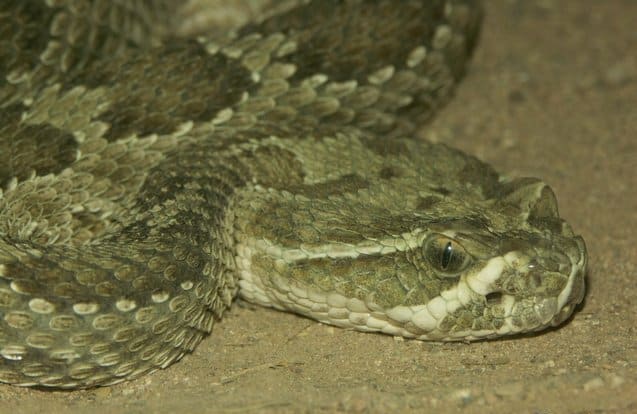
A close relative of the Pacific rattlesnake, this time to the east of the Rocky Mountains. Prairie rattlesnakes live in the great plains, including sweeping grassland and rocky hillsides. Colorado, Kansas, North and South Dakota are all part of their territory. Prairie rattlesnakes eat 90% mammals, including ground squirrels and prairie dogs. Their advanced hunting skill is being able to locate bountiful hunting sites from 25km away, purely via scent.
Prairie rattlesnakes spend all winter in one den, which they return to each year. After emerging in spring, they stay lazy for a while, but then set out on an epic expedition to their summer feeding grounds, which they remain in for months. This can be 10km, 15km or even 25km across the rocky plains. The extreme density of scent particles attracts them to these faraway mammal hotbeds.
Once they arrive, they produce another fistful of skills. Prairie rattlesnakes flatten vegetation like their Pacific relative, and they inject higher quantities of venom into birds than mammals, probably because their venom is less specialised against them. Prairie rattlesnakes also cling onto birds after biting, to prevent them from flying away.
| 7 | Various: homing beacon |

Many snakes have a cunning ability to track prey past envenomation, as though they’ve installed a homing beacon. The likes of coastal taipans can bite an aggressive rodent and instantly stand back, knowing they’ll never lose their prey. A red spitting cobra can inject venom into a foam nest tree frog and keep them permanently on their radar.
Scientists knew for years that a component of venom was responsible, and in 2013, they finally identified the GPS tracker as disintegrins. These toxins disable blood clotting by preventing platelet aggregation, and make up a low proportion in venom – just 2% in the west diamondback rattlesnake. Yet they’ve been given the dual purpose of helping snakes to track their prey post bite. Scientists discovered this by injecting various fractions of a west diamondback venom into mice. One caused the snakes to fleck their tongues with particular interest, and this proved to be rich in two distintegrins.
Originally, scientists had tested the prey’s scent molecules, even pheromones produced during alarm, but to no avail. Exactly how disintegrins act like GPS is a mystery. They could interact with chemicals in a mouse’s body to create a new scent, or they could have a scent of their own.
| 8 | Aquatic garter snake |
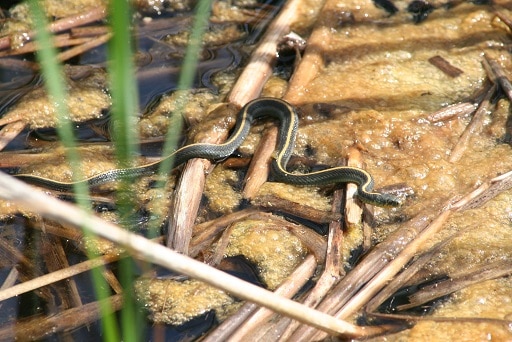
Tail luring is common in snakes, but the aquatic garter snake is one that lures food with its tongue. This species lives in streams of Oregon and California, preferring inland streams at up to 1920 metres above sea level. They’re mildly venomous, but harmless to humans, and get 80-90% of their meals from frogs, a small helping from salamanders.
As adults, they’re more like schoolyard bullies – they just prowl along rocky stream beds and eat any frog that dares to stray close. Juveniles have to be more subtle, and start by hiding in vegetation on the very shore of a river. With their body hidden, they extend their head and poke their tongue through the water surface. By wiggling the black tip, they catch the attention of amphibians, which swim upwards curiously. The aquatic garter snake grabs them and swallows. Northern watersnakes are another species with this ability.
As they reach adulthood, aquatic garter snakes gain massively improved swimming abilities. They move from rocky shallow shores to the centres of streams, and suddenly this tempting trick becomes less necessary.
| 9 | Amazon tree boa |
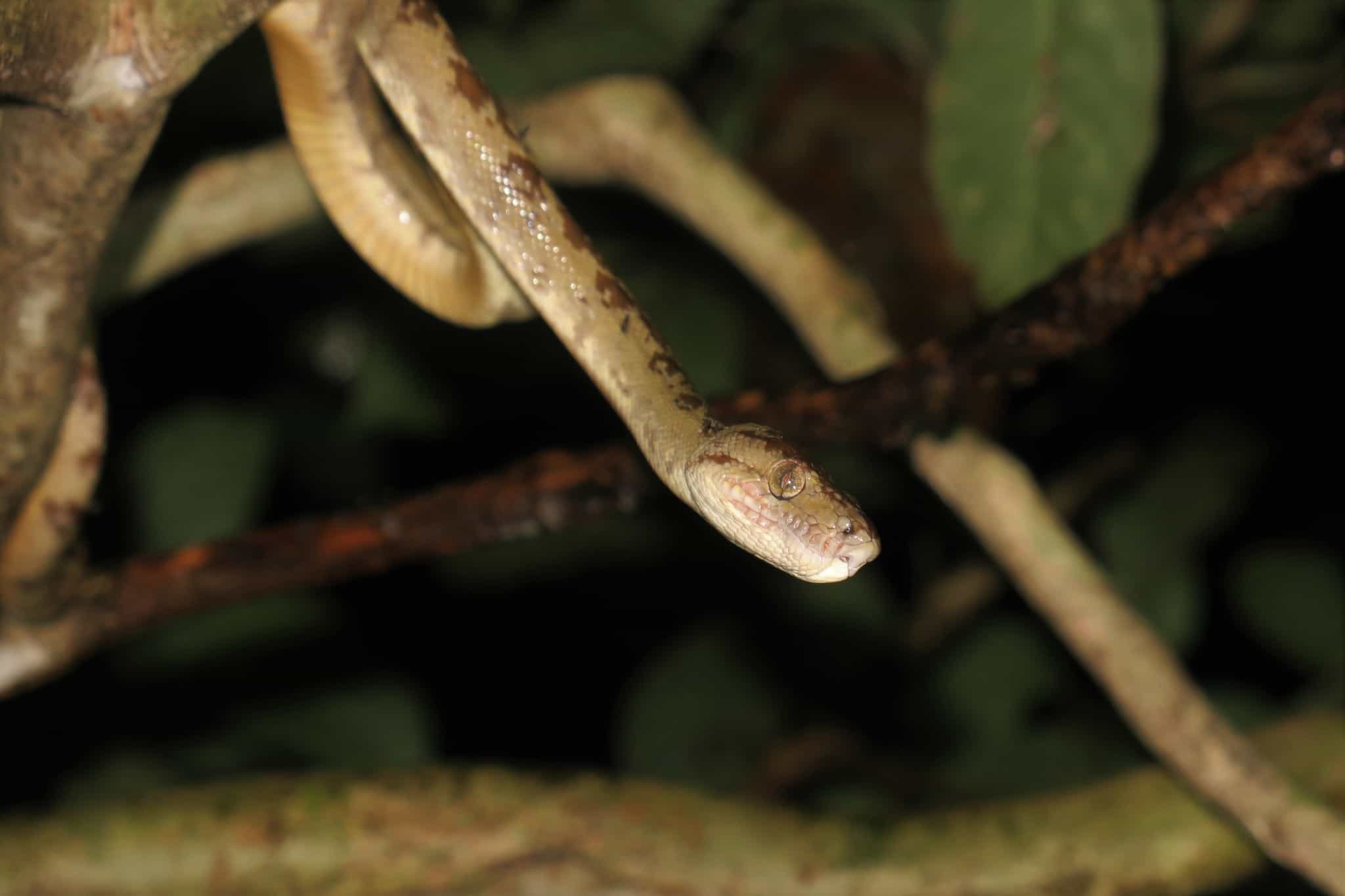
The Amazon tree boa has one of the widest diets of any snake, yet it isn’t just a mindless hoover. They have cunning strategies for individual groups, including bats, one of its favourite food groups. The Amazon tree boa’s trick is to wait directly next to fruits that bats feast on.
This snake is an ambusher, but more active than some, prowling forests and investigating irregularities in its familiar domain. The Amazon tree boa waits and waits, under cloak of darkness, until a bat finally arrives. Then they pounce with all the speed they can muster, without losing accuracy. The bat prey might be caught instantly, or furiously flap its way to freedom. It depends on how well disguised the Amazon tree boa’s initial perch is.
Thanks to this cunning strategy, fruit bats rank highly in its diet: Jamaican fruit bats and dark-fruit eating bats are confirmed prey. Amazon tree boas are also cunning enough to avoid direct moonlight, as this leaves them exposed to predators. They prefer gloomy nights, though avoiding heavy downpours. The Amazon tree boa is mainly a nocturnal hunter.
| 10 | Guatemala neckband snake |
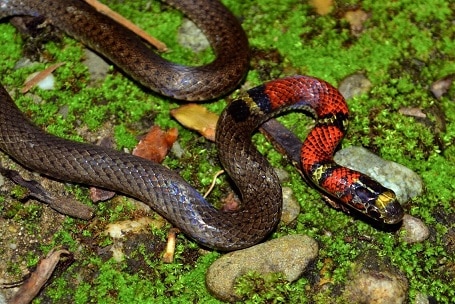
This species has a simple strategy: bury its body in leaves, poke just its head out, and pounce on oblivious prey when they walk past. Guatemala neckbands are a humble species with a thin body and a fragile tail which measures 40% of its tail length, and regularly snaps off. They live in teeming forests of Honduras and Guatemala, and reach a maximum of 92cm.
There’s no way this snake can rugby tackle someone like an Australian death adder: they lack the raw power. Yet they’ve found a cunning niche, using leaves and an assortment of forest mulch accumulated over many years to their advantage. Patience is key to this strategy, and the Guatemalan neckband snake has it in abundance. Their brown bodies (except the neck) blend with the forest floor perfectly.
Guatemalan neckband snakes prey almost entirely on reptiles, and especially skinks. Brown forests skinks are their favourite, and blackbelly centipede snakes have also been recorded. Hiding in leaves, it’s very difficult for humans to spot a Guatemala neckband snake, let alone a skink. The only problem would be if they stuck their head out just a little too far, and the signature red neck started showing.
